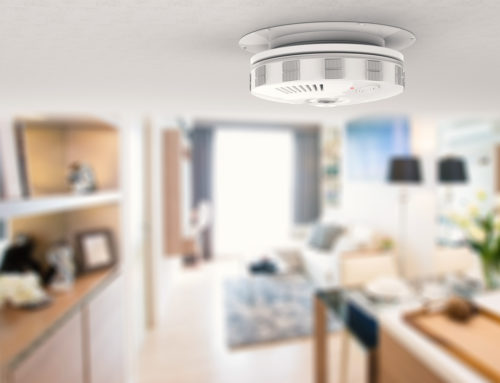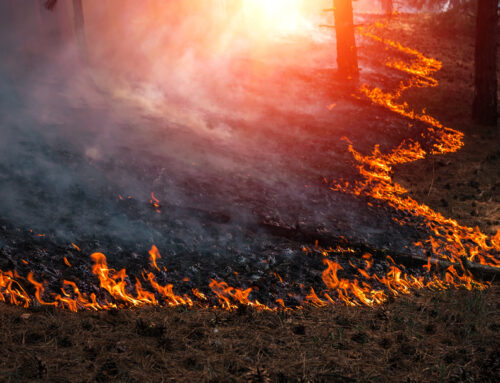Are you and your tenants prepared to deal with a house fire? What may seem like common sense to you might not be to others. Besides, it’s hard to know how people will react when panicked by fire. So, preventing them is your best option. As October is Fire Prevention Month, we wanted to share preventative measures real estate investors and tenants can take to fend off one of the most destructive and deadly losses we see – fires.
Be aware
The first step in fire prevention is understanding what could happen, so let’s start with some statistics. The Consumer Product Safety Commission (CPSC) estimates that there may be as many as 7.4 million house fires each year, and the majority are able to be put out without having to call the fire department. According to the National Fire Protection Association (NFPA), on average, fire departments respond to 358,500 home structure fires each year.
Other statistics:
- One out of every 326 households report a fire each year.
- Seven people die in home fires every day.
- Each year, house fires result in an average of 2,510 civilian deaths, 12,300 injuries, and $6.7 billion in direct damage.
Look for places where fires can start
As you perform your regularly scheduled maintenance and property inspections, keep an eye out for safety issues and address as needed.
Areas where a fire is likely to start:
- Kitchen or cooking area – 43%
- Bedroom – 7%
- Confined chimney or flue – 5%
- Living room, family room, or den – 4%
Leading causes of fires in homes:
- Cooking Equipment – 47%
- Heating Equipment – 15%
- Electrical – 9%
- Intentional – 8%
- Smoking Materials – 5%
Leading Cause #1: Cooking Equipment
According to the National Fire Protection Association, in 2020, ranges or cooktops were involved in 62% of home fires caused by cooking equipment, and unattended equipment was the leading cause of cooking fires and casualties. Providing an operable and safe stove and oven is a basic amenity for most rentals. You might be wondering what more you can do to mitigate cooking fires. You can’t monitor the kitchen 100% of the time, and a cooking test is probably not part of your tenant screening process. However, you can educate tenants on the dangers of cooking fires and the importance of staying in the kitchen while cooking. You could also invest in a product like StoveTop FireStop (STFS). This product is designed to put out unattended cooktop fires. It’s like installing a fire suppression system, only much less expensive and more targeted.
Leading Cause #2: Home Heating Equipment
This equipment includes central heating systems, portable and stationary space heaters, fireplaces, chimneys, heat transfer systems, and water heaters. Regular inspection and servicing of the furnace and water heaters help minimize the risk of malfunction and fires. Educating your tenants on the use of space heaters is also critical. Share the following tips:
- Space heaters should not be the primary heating source in the house.
- Any space heater in use should be equipped with safety features such as automatic shut-off if knocked over.
- Keep a 3-foot safety zone around the heater cleared of any flammables (blankets, toys, pet toys, and any other clutter that might catch fire).
- DO NOT extend the range of the heater by using an extension cord. The extension cord may overheat, becoming a fire hazard.
- Space heaters should not be left unattended or run overnight.
You might also let your tenants know that running a 1,500-watt electric heater 24 hours a day for a month may cost them over $120 on their electric bill!
Lastly, make sure chimneys and fireplaces are inspected and cleaned by a professional annually. The inspection will reveal the health of the chimney and allow any fixes to be made before a chimney fire can occur.
Bonus Tip: Cleaning out dryer vents is a relatively easy task and can save you from a costly fire at your property. Make sure to instruct tenants to clean out the lint trap regularly too!
Leading Cause #3: Electrical
Your electrical system includes fixed wiring, meters or meter boxes, switches, receptacles or outlets, transformers, breakers, cords, plugs, lighting equipment, etc. When you first buy a property, making sure all components of your electrical system are up to code and in good condition is critical. Many insurers won’t cover some types of older wiring (e.g., aluminum or knob and tube), so not only is it unsafe, but if you suffer a loss, you most likely won’t be compensated for that loss either.
During your initial walk-through with tenants, make sure they understand these fire hazards:
- Using too many extension cords and/or multiple multi-outlet strips can cause an overload.
- Covering electrical cords with carpet or other materials can cause them to overheat.
- Using appliances with cords (including extension cords) that are worn or frayed can cause the current to dangerously arc.
- Placing light bulbs too close to flammable items can cause heat to transfer.
Leading Cause #4: Intentionally Set Fires
Intentionally set fires start with deliberate misuse of a heat source. We have heard of occurrences where a tenant set fire to the house because they found out they were evicted. We have also seen instances where squatters trying to stay warm in a vacant home started a fire, causing the house to go up in flames. Unfortunately, firefighters and other innocents have been injured or killed in some of these incidents, leading to arson and secondary homicide charges.
During your regularly scheduled inspections, limiting the flammable items may help decrease the possibility of someone starting a fire at your investment property. Picking up litter, getting rid of firewood, and removing old propane tanks, gas cans, and paint stored around the house can dramatically reduce your risk of fire.
Leading Cause #5: Smoking Materials
You may have a provision in your lease that prohibits your tenant from smoking inside or on the premises. Your reasoning may be to avoid smoke damage or to not run off non-smokers from renting that unit in the future, but it can also keep your tenants and your investment safer. We have seen incidents where someone fell asleep on the living room couch with a cigarette in hand and started a house fire. In some of those instances, we have also seen injuries and fatalities.
The garage is another common smoking spot. However, flammables such as gasoline, paint thinner, and other aerosols are often stored in the garage, creating another dangerous scenario. During your routine inspections, look for discarded cigarette butts on the property. If a tenant throws one into a plant bed, it may ignite a fire that spreads to the house. If your unit is non-smoking, clearly state this in the lease and seriously enforce the rule. People’s lives may depend on it.
Test smoke alarms regularly
Most, if not all, jurisdictions require you to provide working smoke detectors in your rental homes. You might find it shocking to hear that 57% of home fire deaths result from fires where either no smoke alarm was present or an alarm was present but didn’t operate. It’s essential to provide working smoke alarms and test them regularly. Batteries don’t last forever, and neither do smoke alarms. Both need to be changed out regularly. Did you know the life expectancy of a smoke alarm is about ten years, and a carbon monoxide alarm is about five years? Replace any alarms that are over those ages, and change smoke alarm batteries at least twice a year.
During your regularly scheduled inspections, test each alarm. We’ve seen incidents where:
- Tenants decided they didn’t want to be bothered with a chirp when the batteries were getting weak
- Tenants liked to smoke in the house but didn’t like the alarm going off
- A tenant burnt a meal in the kitchen, disconnected the batteries in their smoke detectors, and forgot to reconnect them.
None of these situations turned out well.
Have two ways out of each room
You cannot force your tenants to make an emergency escape plan, but you can help by making sure there are two ways out of every room. In 2013, a 22-year-old Boston University student died in a fire after getting trapped in her attic apartment. The family filed a lawsuit against the landlord and brokers, accusing them of renting an illegal apartment with insufficient exits and a faulty fire alarm system. Don’t find yourself in this situation! Make sure your investment property meets the fire code (e.g., be careful to remedy non-conforming bedrooms), and make an effort to educate your tenants about fire risks around the home. To help your tenants with a fire escape plan, share this short 1½ minute video from the NFPA.
Heeding the above tips can help you and your tenants prevent avoidable fires!






